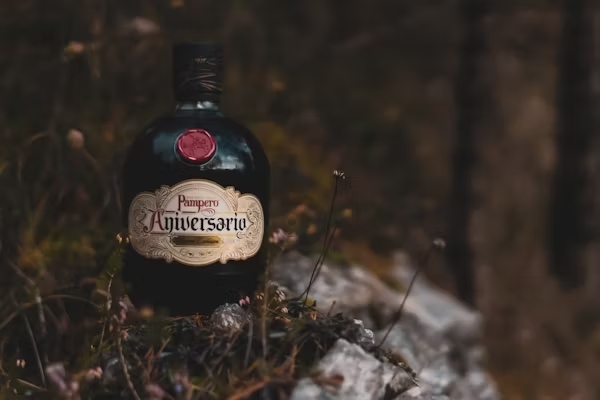BLOG
Rumplemintz: The Bold Peppermint Liqueur That Redefined Winter Spirits

Rumplemintz is a high-proof peppermint schnapps liqueur that has earned a cult-like following among both casual drinkers and seasoned mixologists. Known for its intense peppermint flavor and commanding 100-proof alcohol content, Rumplemintz is far more than a typical mint-flavored spirit—it’s a bold, icy blast of refreshment that doubles as a social staple. Whether sipped in winter to ward off the chill or downed in a shot glass for a bracing night out, Rumplemintz offers a sensory experience that’s as intense as it is invigorating.
What is Rumplemintz? An Overview of the Peppermint Powerhouse
Rumplemintz is a peppermint schnapps liqueur most notable for its stark peppermint intensity and high alcohol content—usually 50% ABV (100-proof). This spirit is crafted from neutral grain alcohol infused with natural peppermint oil, giving it an unmistakably fresh and icy flavor profile. Its trademark gold-foiled label and the image of a double-headed eagle hint at its German heritage, although it’s now widely associated with American nightlife.
The drink stands apart due to its dual characteristics: the clean coolness of peppermint and the warm kick of high-proof alcohol. The experience of drinking Rumplemintz is almost medicinal, reminiscent of menthol lozenges—but with an alcoholic twist that leaves a lingering warmth. It’s popular as a chilled shot, particularly during winter or festive seasons, and is often shared among groups seeking a quick, palate-cleansing experience.
Despite its potency, Rumplemintz is surprisingly smooth, owing to its precise balance of flavor and alcohol. This unique blend has earned it a dedicated fan base and a spot on the shelf in many bars and home collections across North America and Europe.
Historical Roots: From German Origins to Global Appeal
While today it’s widely available in American bars and liquor stores, Rumplemintz’s origins are deeply rooted in German distillation traditions. Germany has long been recognized for its precision in crafting schnapps, a category that includes various fruit and herb-flavored spirits. Peppermint, being one of the most therapeutic and pungent herbs, became a natural candidate for flavor infusion.
Originally marketed as a digestif—a post-meal drink that aids digestion—peppermint schnapps grew popular in alpine regions. The German influence is still visible in Rumplemintz’s branding, from its double-headed eagle crest to its Teutonic name. Although the production now takes place under the Sazerac Company in the United States, the brand remains faithful to its German heritage.
In the 1990s, Rumplemintz experienced a surge in popularity in the U.S., particularly among college students and winter sport enthusiasts. Its crisp, clean taste and warming sensation made it a perfect après-ski shot or holiday toast. Over the decades, its appeal has expanded beyond seasonal trends to become a mainstay in nightlife culture and social drinking scenarios.
The Flavor Profile: Cool, Crisp, and Confrontational
What sets Rumplemintz apart from other liqueurs is its unrelenting peppermint intensity. One sip delivers a flavor that is sharply mentholated yet paradoxically smooth. Unlike other flavored liqueurs that dilute their taste with sugar or citrus, Rumplemintz embraces the purity of peppermint. This singular focus on one bold note has become its defining feature.
The high alcohol content elevates the sensory experience. At 100-proof, the burn is palpable but not overpowering. The peppermint oils soothe the throat just as the alcohol creates a warming sensation in the chest. This duality makes it equally suitable for icy shots and as a base in warming winter cocktails.
Consumers often describe Rumplemintz as both “refreshing” and “intense,” a paradox that underpins its enduring popularity. It’s the kind of drink that startles the senses but keeps you coming back. “It’s like drinking liquid breath mint—but with consequences,” one bartender jokingly noted, capturing its paradoxical allure.
Popular Rumplemintz Cocktails and How to Craft Them
Although best known as a shooter, Rumplemintz lends itself surprisingly well to a variety of cocktails. Its strong minty character can either play the lead role or act as a powerful supporting note. Here are several popular ways to mix Rumplemintz that go beyond the classic shot:
- Frozen Mint Mocha: Blend Rumplemintz with coffee liqueur and chocolate syrup, topped with whipped cream.
- Icy Mule: Mix Rumplemintz with ginger beer and lime juice for a minty twist on the Moscow Mule.
- Mint Hot Chocolate: Add a shot of Rumplemintz to hot cocoa for a warm, spiked winter beverage.
- Polar Martini: Shake with vanilla vodka and a splash of cream for a dessert-like experience.
Each of these cocktails amplifies Rumplemintz’s core flavor while softening its sharp edges, making it more approachable for those new to peppermint spirits. Mixologists often emphasize balance, using Rumplemintz sparingly to avoid overpowering other ingredients. Its potency is both its strength and its limitation in mixology.
Rumplemintz vs Other Schnapps: How It Compares
Rumplemintz sits in a unique category of schnapps due to its combination of flavor concentration and alcohol strength. While schnapps like DeKuyper Peppermint or Goldschläger offer flavored spirits with lower ABVs and sweeter profiles, Rumplemintz remains unapologetically bold. Here’s a comparative breakdown:
| Brand | Flavor | Alcohol Content (ABV) | Notes |
|---|---|---|---|
| Rumplemintz | Peppermint | 50% (100-proof) | Intense, crisp, dry |
| DeKuyper | Peppermint | 30% (60-proof) | Milder, sweeter |
| Goldschläger | Cinnamon | 43.5% (87-proof) | Contains real gold flakes |
| Dr. McGillicuddy’s | Mint | 24% (48-proof) | Creamier, medicinal |
| Aftershock | Cool Cinnamon | 30% (60-proof) | Sweet with spicy finish |
This table illustrates how Rumplemintz leads the pack in strength and flavor purity. Its role is not to be subtle—it’s for drinkers who appreciate a shot that doesn’t hold back.
A Symbol of Strength and Ritual in Nightlife Culture
Rumplemintz has transcended its identity as just another schnapps; it has become a ritualistic drink, particularly in American bar culture. Among patrons, it’s often ordered in rounds for its theatrical quality. The act of braving a Rumplemintz shot together fosters camaraderie, much like other high-proof liquors such as tequila or whiskey.
Many bar-goers recount stories where Rumplemintz marked a turning point in the night—the drink before the wild times began. “It’s a minty dare,” as one regular joked at a ski-town pub. Its frosty finish and strong hit make it ideal for celebrations, dares, or simply resetting the palate between other drinks.
Interestingly, bartenders also recommend Rumplemintz as a post-dinner digestif. The peppermint oil can aid digestion and freshen breath, making it a practical, if potent, way to conclude a meal. Its social role, therefore, extends from practical function to party starter.
Rumplemintz in Seasonal and Holiday Traditions
During the colder months, Rumplemintz sees a significant spike in consumption, particularly around the winter holidays. Its flavor and warming sensation make it a natural companion for snowy evenings, Christmas parties, and après-ski events. Paired with cocoa, coffee, or even spiked eggnog, Rumplemintz adds festive flair to any winter celebration.
Some households even craft custom holiday drinks featuring Rumplemintz as the key ingredient. Recipes often include crushed candy canes, whipped cream, and marshmallows. It’s a way to integrate the liqueur into family-friendly settings, albeit with caution due to its strength.
Its visual branding, with snowy imagery and frosty tones, also aligns with winter aesthetics. As one enthusiast shared, “Rumplemintz is basically Christmas in a bottle—if Christmas came with a 100-proof punch.” The association with warmth, peppermint, and winter together make it a staple in cold-weather liquor cabinets.
The Nutritional and Health Perspective: Drink Responsibly
Given its alcohol content, Rumplemintz is not a casual drink and should be consumed responsibly. One shot contains a high volume of alcohol, and due to its smoothness, people often underestimate its potency. Overconsumption can easily lead to intoxication, especially for those unaccustomed to 100-proof spirits.
Here’s a brief nutritional overview per 1.5 oz serving:
| Nutrient | Approximate Value |
|---|---|
| Calories | 187 kcal |
| Carbohydrates | 10 g |
| Sugars | 10 g |
| Alcohol | 21 g |
The sugar content stems from the peppermint syrup base, and while not excessive, it’s enough to make the drink high in both calories and sweetness. Diabetics and those managing caloric intake should be particularly cautious. Furthermore, mixing it with dairy (such as in a polar martini or minty hot chocolate) can add even more calories.
Beyond the Glass: Alternative Uses for Rumplemintz
Though primarily known as a beverage, Rumplemintz has found uses outside of drinking culture. Due to its intense peppermint essence, some creative individuals have repurposed it in unconventional ways—ranging from culinary infusions to home remedies. While these uses are not officially endorsed, they reveal the drink’s versatility and cultural imagination.
Some people use a small amount of Rumplemintz in baking recipes, such as peppermint brownies or adult-only frostings, to give desserts an extra kick. Others add it to homemade whipped cream for a boozy topping on hot beverages. Its high alcohol content also means it can act, in moderation, as a breath freshener substitute—though this is neither recommended nor sustainable.
In spa settings, peppermint is known for its soothing, muscle-relaxing qualities. A few drops of Rumplemintz diluted in bath water (strictly for aromatherapy) have reportedly been used to relax muscles, although this practice comes with risks due to alcohol’s dehydrating effect on skin.
While these uses are more anecdotal than clinical, they add depth to the spirit’s reputation as more than just a party favorite.
Rumplemintz in Pop Culture and Media References
Over the years, Rumplemintz has quietly secured a place in American pop culture. Its name, both humorous and memorable, lends itself to storytelling. Whether appearing in sitcom punchlines, late-night anecdotes, or stand-up routines, Rumplemintz is often cited as the liquor that leads to memorable (and sometimes regrettable) nights.
A 2010 stand-up special included the line, “I knew it was a bad idea when Rumplemintz entered the chat,” capturing its infamous role in party escalation. In college comedies and bar-themed movies, it’s often the drink of choice when characters want to ‘go hard’ without turning to darker spirits like whiskey or absinthe.
Online forums and social media frequently feature memes and stories involving the drink. On Reddit threads like r/TalesFromYourBartender, Rumplemintz is affectionately referred to as the “liquid courage of peppermint.” These appearances have helped preserve its status as both nostalgic and current, bridging generations of drinkers.
Myths and Misconceptions About Rumplemintz
Rumplemintz, like many iconic beverages, carries with it a fair share of myths and misconceptions. The most pervasive myth is that its high alcohol content makes it inherently dangerous. While 100-proof is strong, responsible consumption makes it no more dangerous than other high-proof spirits such as bourbon or overproof rum.
Another common belief is that Rumplemintz can “cure a cold” due to its menthol flavor and warming properties. While it might temporarily relieve congestion or sore throats, it is not a substitute for medicine. “It feels like it’s killing germs on the way down,” joked one fan, but this is a psychological comfort rather than a scientific truth.
Some believe it’s only a holiday drink, yet statistics from bars show consistent year-round sales. Its popularity in summer is tied to frozen mint cocktails and palate cleansers between courses. Its adaptability is more dynamic than people assume, making Rumplemintz a drink for all seasons—not just December.
The Branding: How Rumplemintz Stands Out on Shelves
The visual branding of Rumplemintz is an essential part of its identity. The double-headed eagle, gold foil label, and icy blue accents all signal strength, tradition, and freshness. This branding leans heavily into its Germanic roots, evoking a sense of historic authority and mystique.
The bottle is sleek, transparent, and minimalist—allowing the clarity of the liquid to reflect purity. This aligns with the brand’s positioning as a straightforward, no-nonsense peppermint schnapps. Unlike more flamboyant liqueurs that rely on colorful infusions or gimmicky packaging, Rumplemintz exudes a sober strength, making it appealing to both young and mature drinkers.
Marketing campaigns for Rumplemintz tend to favor word-of-mouth and organic growth over flashy advertisements. It thrives on reputation and tradition rather than trendiness. This approach has given it longevity in an ever-changing liquor market. As one marketer noted, “Rumplemintz doesn’t chase the crowd. It waits for the brave to find it.”
Environmental and Ethical Considerations in Production
In today’s environmentally conscious world, many consumers want to know how their spirits are made. While Rumplemintz does not heavily advertise its sustainability efforts, it’s important to understand the broader context of schnapps production. Peppermint oil extraction is generally eco-friendly and requires fewer pesticides compared to fruit-based ingredients.
The neutral grain spirits used as the base are typically derived from corn, wheat, or rye—ingredients that can be sustainably sourced depending on the region. Distilleries producing Rumplemintz under the Sazerac Company umbrella are part of a broader movement toward cleaner production, including waste reduction, recycling programs, and energy-efficient distilling equipment.
Ethical labor practices in ingredient sourcing and bottling facilities are also being emphasized more in recent years. Though not as transparent as some craft distillers, Rumplemintz benefits from a production process that is largely responsible when compared to global industry standards.
Rumplemintz Collectors and Limited Editions
While it may seem surprising, there is a niche community of collectors who seek out rare editions and promotional items tied to Rumplemintz. These include holiday packaging, barware with logos, vintage bottles from early production years, and even apparel given out during bar promotions.
Some limited holiday editions feature unique labeling or frosted bottles that become collectibles over time. Others are prized for being part of bar campaigns or regional releases in Europe. Online marketplaces such as eBay and specialty liquor forums occasionally feature Rumplemintz memorabilia, revealing a subculture of brand loyalty.
Collectors often value Rumplemintz for its role in memory and nostalgia. “This bottle was from my first ski trip in the ’90s,” one enthusiast shared. For many, the brand represents more than flavor—it embodies moments of youth, camaraderie, and celebration.
Bullet-Point Summary: Key Takeaways on Rumplemintz
- Rumplemintz is a 100-proof peppermint schnapps known for its intense flavor and iconic branding.
- Originated in Germany, now produced by Sazerac Company with a strong U.S. market presence.
- Primarily consumed as a chilled shot, but also versatile in cocktails and desserts.
- High-proof alcohol paired with menthol creates a paradoxical warming-cooling effect.
- Nutritionally rich in calories and sugars, best enjoyed in moderation.
- Popular myths exaggerate its medicinal properties; it’s a comfort drink, not a cure.
- A staple in winter traditions, but adaptable for year-round use in creative beverages.
- Recognized for clean branding, nostalgic value, and a loyal community of fans.
Conclusion: The Everlasting Chill of Rumplemintz in a Changing World
Rumplemintz is more than just a bottle on the back bar—it’s a symbol of resilience in a liquor landscape flooded with fleeting trends. Its appeal lies not in flashiness, but in clarity of purpose. It offers one thing, and it does it better than anyone else: a piercingly pure peppermint shot that awakens the senses and ignites the room.
BLOG
ReaperScans Unveiled: The Best Free Resources for Manga Lovers

Are you a manga enthusiast searching for your next great read? If so, you’re in for a treat. ReaperScans is quickly becoming the go-to platform for manga lovers everywhere. With its diverse library and user-friendly interface, it offers something special to both casual readers and die-hard fans alike. Whether you’re looking to dive into thrilling adventures or heartwarming romances, ReaperScans has got you covered.
What started as a small community-driven project has blossomed into an extensive repository of titles that cater to all genres. The best part? It’s completely free! So grab your favorite snacks, settle in, and let’s explore what makes ReaperScans a must-visit destination for every manga lover out there.
What is ReaperScans and its History
ReaperScans is a digital haven for manga fans, offering an impressive collection of titles across various genres. Founded by passionate readers and artists, it began as a simple scanlation group dedicated to sharing beloved stories with the world.
Over time, ReaperScans evolved into a thriving community where users can not only read but also engage in discussions about their favorite series. The platform prioritizes quality content while ensuring that every release meets high standards of translation and artwork.
With its user-friendly interface and frequent updates, ReaperScans has become synonymous with free manga access. This commitment fosters a welcoming environment for newcomers and veterans alike. As the library continues to grow, so does the excitement surrounding upcoming releases that keep readers coming back for more.
Top 5 Manga Titles Available on ReaperScans
ReaperScans boasts an impressive collection of manga titles that cater to diverse tastes. Here are five standout selections.
First up is “Tomo-chan Is a Girl!” This romantic comedy follows Tomo, who struggles to have her childhood friend see her as more than just a buddy. The humor and relatable characters make it a must-read.
Next, don’t miss “Solo Leveling.” This action-packed series immerses readers in a world where hunters battle monstrous threats. The stunning artwork enhances the thrilling storyline.
For those yearning for fantasy, “The Beginning After the End” offers an incredible journey of reincarnation and self-discovery. Its rich lore keeps fans engaged from start to finish.
Another gem is “My Dress-Up Darling.” It beautifully blends romance with the art of cosplay, showcasing creativity through its captivating narrative.
Lastly, “Jujutsu Kaisen” has gained immense popularity for its gripping plot and dynamic battles involving curses and sorcerers. These titles truly highlight what ReaperScans has to offer.
How to Use ReaperScans: A Step by Step Guide
Using ReaperScans is straightforward and user-friendly. Start by visiting the official website. The clean layout makes navigation easy.
Once on the homepage, browse through various manga categories or use the search bar for specific titles. Popular series often feature prominently, helping you discover new reads.
Click on a title to access its dedicated page. Here, you’ll find chapter lists along with summaries and release dates. Select your desired chapter to read it online or download it for offline enjoyment.
The reading interface allows for zooming in and out, enhancing your experience whether you’re using a computer or mobile device.
Don’t forget to check back regularly for updates or new releases from your favorite series! Engaging with comments can also connect you with fellow fans who share similar tastes in manga.
Benefits of Using ReaperScans for Manga Reading
ReaperScans offers a seamless reading experience for manga enthusiasts. With an extensive library, you can easily discover titles across various genres. Whether you’re into action, romance, or horror, there’s something for everyone.
The user-friendly interface makes navigation a breeze. You can quickly find your favorite series and track new chapters effortlessly. This convenience keeps readers engaged and coming back for more.
One of the standout features is the quality of scans. Each manga is presented in high resolution, preserving the artwork’s intricate details that fans cherish.
Additionally, ReaperScans often updates its collection with the latest releases. Staying current means never missing out on trending stories or beloved characters.
Community involvement enhances your reading journey too. Readers connect over shared interests and recommendations within forums and comments sections, fostering a sense of belonging among manga lovers everywhere.
Alternatives to ReaperScans for Manga Lovers
For manga enthusiasts seeking alternatives to ReaperScans, several platforms offer diverse selections and unique features.
MangaDex is a popular choice, boasting an extensive library of titles across various genres. Its user-friendly interface makes it easy to navigate.
Another option is MangaRock, which provides a curated collection of both mainstream and indie works. The app also allows for offline reading, making it convenient for on-the-go fans.
If you enjoy community interaction, check out MyAnimeList. Besides manga chapters, users can engage in discussions about their favorite series and authors.
Webtoons offers a different format with vertical scrolling comics that cater to modern storytelling styles. It’s perfect for those who want something fresh alongside traditional manga.
Each platform has its strengths and caters to different preferences within the vibrant world of manga reading.
Featured Artists and Upcoming Releases on ReaperScans
ReaperScans showcases a vibrant community of talented artists, bringing fresh stories and captivating art to manga lovers everywhere. The platform is dedicated to highlighting both established creators and emerging talents, ensuring an exciting mix for readers.
Keep an eye out for upcoming releases featuring fan-favorite series alongside new titles that promise to make waves in the manga world. Each month brings something unique, whether it’s a gripping thriller or a heartwarming slice-of-life tale.
The collaborative spirit at ReaperScans also means fans can engage with their favorite artists directly. Many creators share insights into their work processes through behind-the-scenes content and Q&A sessions.
This connection between artists and readers fosters a sense of community that’s hard to find elsewhere. As you explore the ever-expanding library on ReaperScans, you’ll discover not just stories but the passion that drives these incredible creatives forward.
Conclusion
ReaperScans has become a beloved platform for manga enthusiasts, offering easy access to a variety of titles and an engaging community. With its extensive library and user-friendly interface, readers can easily find their next favorite series without breaking the bank.
The top five manga titles available on ReaperScans showcase both popular mainstream hits and hidden gems, ensuring there’s something for everyone. Navigating the site is straightforward, allowing users to jump right into reading with minimal fuss.
Utilizing ReaperScans comes with numerous benefits: it’s free, offers high-quality scans, and fosters connection among fans through discussions about ongoing stories. For those looking for alternatives or different experiences in the manga world, other platforms are available that cater to diverse tastes.
Featuring talented artists who contribute new works regularly keeps the content fresh and exciting. Upcoming releases promise even more thrilling adventures for avid readers.
For anyone passionate about manga or just starting out in this vibrant genre, exploring what ReaperScans has to offer could be your gateway into countless hours of enjoyment.
BLOG
How to Use FLVTO Effectively: A Step-by-Step Tutorial

Introduction to FLVTO
Are you tired of searching for ways to download your favorite YouTube videos? Look no further! FLVTO is here to simplify the process and make downloading a breeze. Whether you’re looking for music, tutorials, or entertainment clips, this powerful tool allows you to convert and save content effortlessly. With just a few clicks, you can have high-quality files ready for offline enjoyment. In this tutorial, we’ll walk you through each step of using FLVTO effectively so that you can maximize its potential. Ready to dive in? Let’s get started!
Step 1: Download and Install FLVTO
To get started with FLVTO, the first step is downloading and installing the software. Head over to the official FLVTO website for a safe and reliable download. This ensures you’re getting the latest version without any added malware.
Once you land on the site, look for an easy-to-find “Download” button. Click it to initiate your download process. Depending on your internet speed, this should only take a moment.
After downloading, locate the file in your downloads folder or wherever files are saved by default. A simple double-click will start the installation wizard. Follow the prompts carefully; they guide you through each stage of setup.
Make sure to accept any terms of service if prompted, as this is standard practice during installations. Soon enough, FLVTO will be ready for use on your device!
Step 2: Copy the YouTube Video Link
To utilize FLVTO effectively, the next step is to copy the YouTube video link.
Start by navigating to YouTube and find the video you want. Play it briefly or just get a glimpse to ensure it’s what you’re after.
Once you’ve identified your choice, look for the URL in your browser’s address bar at the top. It’s typically a long string starting with “https://”.
Highlight this entire link carefully. Right-click and select “Copy” or use keyboard shortcuts like Ctrl+C on Windows or Command+C on Mac.
Now that you have the link stored in your clipboard, you’re ready for the next step in this simple process!
Step 3: Paste the Link in FLVTO
Once you’ve copied the YouTube video link, it’s time to head over to FLVTO. The interface is user-friendly and straightforward, making this step a breeze.
Locate the designated box on the site where you can paste your video link. Simply click inside that area and use either right-click or keyboard shortcut (Ctrl + V) to insert your URL.
Ensure there are no extra spaces or characters in the link after pasting. A clean link guarantees smoother processing later on.
After pasting, take a moment to double-check everything looks correct. Typos can lead to errors during conversion, so it’s worth confirming before proceeding.
With your video link successfully inserted into FLVTO, you’re ready for the next exciting steps in transforming that content into your preferred format!
Step 4: Choose Your Preferred File Format
Once you’ve pasted the YouTube link into FLVTO, it’s time to pick your file format. This choice is crucial as it determines how you’ll access the audio or video later.
FLVTO offers various formats like MP3, MP4, and more. If you’re looking for audio only, MP3 is a solid option. It provides excellent sound quality while keeping file sizes manageable.
For a complete viewing experience, consider selecting MP4 if you want both picture and sound. It’s widely compatible with most devices and platforms.
Take a moment to think about where you’ll play this file. Different devices may support different formats better than others. Choosing wisely ensures smooth playback without hiccups down the line.
Your selection here can enhance your overall enjoyment of the content you’ve chosen to download from YouTube through FLVTO.
Step 5: Click “Convert To” Button
After selecting your preferred file format, it’s time for the final step. Locate the “Convert To” button on FLVTO’s interface.
This button is your gateway to transforming that video link into a downloadable file. Clicking it initiates the conversion process, which typically takes just a few moments. You’ll see a progress bar indicating how far along the conversion is.
Stay patient during this brief wait; it won’t take long for your file to be ready. Once complete, you will receive an option to download your newly converted audio or video file.
Make sure to keep an eye out for any prompts that may appear after clicking “Convert To.” These often guide you through saving your content seamlessly and quickly!
Tips for Optimal Use of FLVTO
To make the most of FLVTO, start by ensuring a stable internet connection. A reliable network will speed up your downloads and reduce errors.
Next, check the quality settings before converting files. Higher bit rates yield better audio experiences. Don’t settle for mediocre sound when you can have crisp clarity.
Also, keep an eye on file sizes. Sometimes larger files take longer to download or may require more storage space than anticipated. Adjust your format choice accordingly.
Utilize FLVTO’s options wisely. There are various formats available—choose one that suits your playback device best, whether it’s MP3 for music or MP4 for video content.
Stay updated with any new features or changes in FLVTO’s interface. This ensures you’re using all available tools effectively without missing out on enhancements that could improve your experience further.
Troubleshooting Common Issues
Using FLVTO can occasionally present some challenges. If you find that your video isn’t converting, check the link first. Ensure it’s copied correctly from YouTube without any extra spaces or characters.
Another common issue is slow conversion times. This might be due to heavy traffic on the site or a temporary glitch. Try refreshing the page or waiting a few moments before attempting again.
If you encounter format compatibility problems, double-check that your chosen output format is supported by FLVTO. Switching between formats can sometimes resolve unexpected issues.
If you’re experiencing persistent errors, consider clearing your browser’s cache and cookies. A fresh start may help eliminate hidden obstacles hindering performance.
Conclusion
Using FLVTO can enhance your media experience by allowing you to convert YouTube videos into audio and video formats easily. Following the steps outlined ensures a smooth conversion process, whether you’re looking for music tracks or educational content. Remember to take advantage of the tips shared for optimal use, which can help prevent common issues that users might face.
With FLVTO in your toolkit, accessing multimedia from YouTube becomes simple and efficient. Now you’re equipped with all the essential knowledge to make the most out of this powerful tool. Happy converting!
BLOG
LittleMinaxo: The Rise of a Digital Creator Redefining Online Influence and Creativity

In the modern era of social media and digital creativity, new voices and personalities continue to shape how audiences interact with art, culture, and self-expression online. Among these rising figures, LittleMinaxo has emerged as a unique and inspiring presence — a creator whose originality, authenticity, and artistic vision set them apart in a crowded digital landscape.
Whether it’s through captivating visuals, thought-provoking storytelling, or creative collaborations, LittleMinaxo has built a community that values individuality and emotional connection. Their journey reflects the transformation of content creation into a genuine form of artistic and cultural influence.
The Story Behind LittleMinaxo
Every creator begins with a story, and LittleMinaxo’s path is rooted in creativity, self-discovery, and persistence. Starting as a small independent content creator, LittleMinaxo began sharing personal projects online — ranging from digital art and short videos to music and lifestyle content.
What started as a simple passion quickly grew into a movement. Followers resonated with LittleMinaxo’s message of authentic self-expression and emotional honesty, finding comfort and inspiration in their unique perspective.
Over time, LittleMinaxo transformed from a social media username into a brand symbolizing individuality, empowerment, and creativity without limits.
Creative Identity and Aesthetic
The name LittleMinaxo itself reflects a blend of playfulness (“Little”) and strength (“Minaxo”). It suggests a personality that balances soft creativity with bold confidence, which is evident in their content style and personal branding.
Visually, LittleMinaxo’s work embraces vibrant colors, imaginative storytelling, and emotional depth. Whether designing artwork, curating social feeds, or collaborating on brand campaigns, they maintain a consistent aesthetic rooted in authenticity and artistic intention.
This blend of relatability and innovation makes LittleMinaxo’s creative identity instantly recognizable — a key reason for their growing digital influence.
Social Media Presence and Growth
LittleMinaxo has become known for a strong social media presence across platforms like Instagram, TikTok, YouTube, and X (formerly Twitter). Each channel showcases a different aspect of their creativity:
-
Instagram: A portfolio of digital art, fashion inspiration, and personal storytelling.
-
TikTok: Short, expressive videos that combine humor, relatability, and social commentary.
-
YouTube: Long-form creative projects, behind-the-scenes content, and collaborations.
-
Twitter/X: Insights, updates, and engaging with followers through open conversations.
Through consistent engagement, LittleMinaxo has cultivated a loyal following who value creativity and emotional connection over trends or algorithms. Their rise demonstrates how authentic content resonates more deeply than manufactured perfection.
The Message Behind LittleMinaxo’s Work
What makes LittleMinaxo stand out isn’t just the content they create — it’s the message behind it. Every post, video, or project carries a deeper narrative about self-love, individuality, and resilience.
In a digital age dominated by comparison and filters, LittleMinaxo encourages followers to embrace imperfection, creativity, and self-expression. Their message is simple but powerful: being real is the most revolutionary act online.
This philosophy has helped LittleMinaxo build not just a fan base, but a community — a collective of people who find inspiration in creativity and honesty.
Collaborations and Partnerships
As their influence has grown, LittleMinaxo has collaborated with both independent brands and major companies looking to connect with Gen Z and millennial audiences.
Their partnerships focus on authentic alignment, working only with brands that reflect their core values — creativity, inclusivity, and sustainability.
Some collaborations include:
-
Fashion labels promoting ethical and body-positive designs.
-
Tech and lifestyle brands emphasizing digital wellness.
-
Art collectives focused on supporting young, diverse creators.
Through these projects, LittleMinaxo has proven that influencer marketing can be both purpose-driven and commercially successful when guided by integrity and creative authenticity.
Artistic Expression and Digital Innovation
At its heart, LittleMinaxo is an artist. Their digital creations blend elements of visual storytelling, graphic design, and multimedia performance. They use technology not just as a tool, but as a canvas for emotional expression.
From animated digital art to music-infused visual reels, LittleMinaxo’s work captures the essence of modern creativity — where art, emotion, and technology converge.
By constantly experimenting with new mediums like AI-generated art, VR design, and interactive storytelling, LittleMinaxo remains ahead of digital trends, setting a standard for what the next generation of creators can achieve.
Community Building and Audience Engagement
What separates LittleMinaxo from many influencers is their commitment to building genuine relationships with followers. Instead of focusing solely on numbers, they emphasize interaction, empathy, and shared creativity.
Through Q&A sessions, live chats, and collaborative art projects, followers are encouraged to contribute ideas and co-create content. This interactive approach transforms passive audiences into active participants in the creative process.
It’s this community-driven model that makes LittleMinaxo’s online presence feel less like a brand and more like a movement of shared inspiration.
Representation and Inclusivity
In addition to creativity, LittleMinaxo advocates for representation and inclusivity across all digital spaces. Their content often highlights themes of diversity, body positivity, and cultural awareness.
By sharing personal experiences and supporting underrepresented voices, LittleMinaxo helps broaden the conversation around inclusivity in digital media.
This focus has inspired countless followers — especially younger audiences — to express themselves freely and proudly, no matter their background or identity.
Challenges and Growth Journey
Like many modern creators, LittleMinaxo has faced challenges on their journey. From dealing with online negativity to navigating platform algorithms, maintaining authenticity while growing an audience hasn’t always been easy.
However, these experiences have only strengthened their resolve to create meaningful content over viral trends. Their openness about burnout, creative blocks, and digital pressure makes them relatable and human — a rare quality in today’s influencer culture.
By sharing both the highs and lows of their journey, LittleMinaxo continues to prove that vulnerability can coexist with creativity and success.
Digital Entrepreneurship and the Brand of LittleMinaxo
Beyond being an individual creator, LittleMinaxo has evolved into a personal brand and creative business. Their projects now include:
-
Merchandise lines featuring original art and design.
-
Digital courses and mentorships for aspiring creators.
-
Collaborative campaigns with artists and small businesses.
This entrepreneurial expansion reflects LittleMinaxo’s understanding of how creativity can also be a sustainable profession. By merging art and business ethics, they’re building a long-term brand that balances authenticity with ambition.
Cultural Influence and Online Legacy
As part of a new generation of digital creators, LittleMinaxo represents more than just social media success. They embody a cultural shift toward genuine expression, inclusivity, and creativity as identity.
Their influence reaches beyond entertainment — inspiring fans to create, think, and live more authentically. For many followers, LittleMinaxo’s journey serves as proof that creativity, kindness, and individuality still have a place in the ever-evolving world of the internet.
The Future of LittleMinaxo
Looking forward, LittleMinaxo continues to explore new creative directions — from digital fashion to immersive virtual experiences. Their upcoming projects are expected to blend technology, emotion, and artistry even further.
By experimenting with AI-driven tools, 3D design, and brand storytelling, LittleMinaxo is redefining what it means to be a creator in the digital age.
Their ultimate goal is clear: to build a lasting creative legacy that inspires others to embrace their own imagination and live authentically in both the real and digital worlds.
Conclusion
In a world where trends fade quickly and attention spans shrink, LittleMinaxo stands out by staying true to one principle — authenticity never goes out of style.
Their journey from independent creator to digital influencer is a testament to the power of creative vision, emotional honesty, and consistent innovation.
-

 TECH3 months ago
TECH3 months ago185.63.263.20: Insights into This Unusual IPv4 Address
-

 BLOG3 months ago
BLOG3 months agoXaller: A Comprehensive Guide to Understanding Its Significance and Applications
-

 BLOG3 months ago
BLOG3 months agoKorpenpelloz: An In-Depth Exploration of Its Significance
-

 BLOG3 months ago
BLOG3 months agoRosy Kellogg: Uncovering the Life and Legacy of a Renowned Figure
-

 BLOG3 months ago
BLOG3 months agoCarmenton.xyz: Everything You Need To Know
-

 HOME3 months ago
HOME3 months agoTEK-102: A Comprehensive Guide to Its Features, Uses, and Industry Impact
-

 BLOG3 months ago
BLOG3 months agoZepbound: A Comprehensive Guide to Weight Loss
-

 BLOG3 months ago
BLOG3 months agoAmikaf16: An In-Depth Overview
